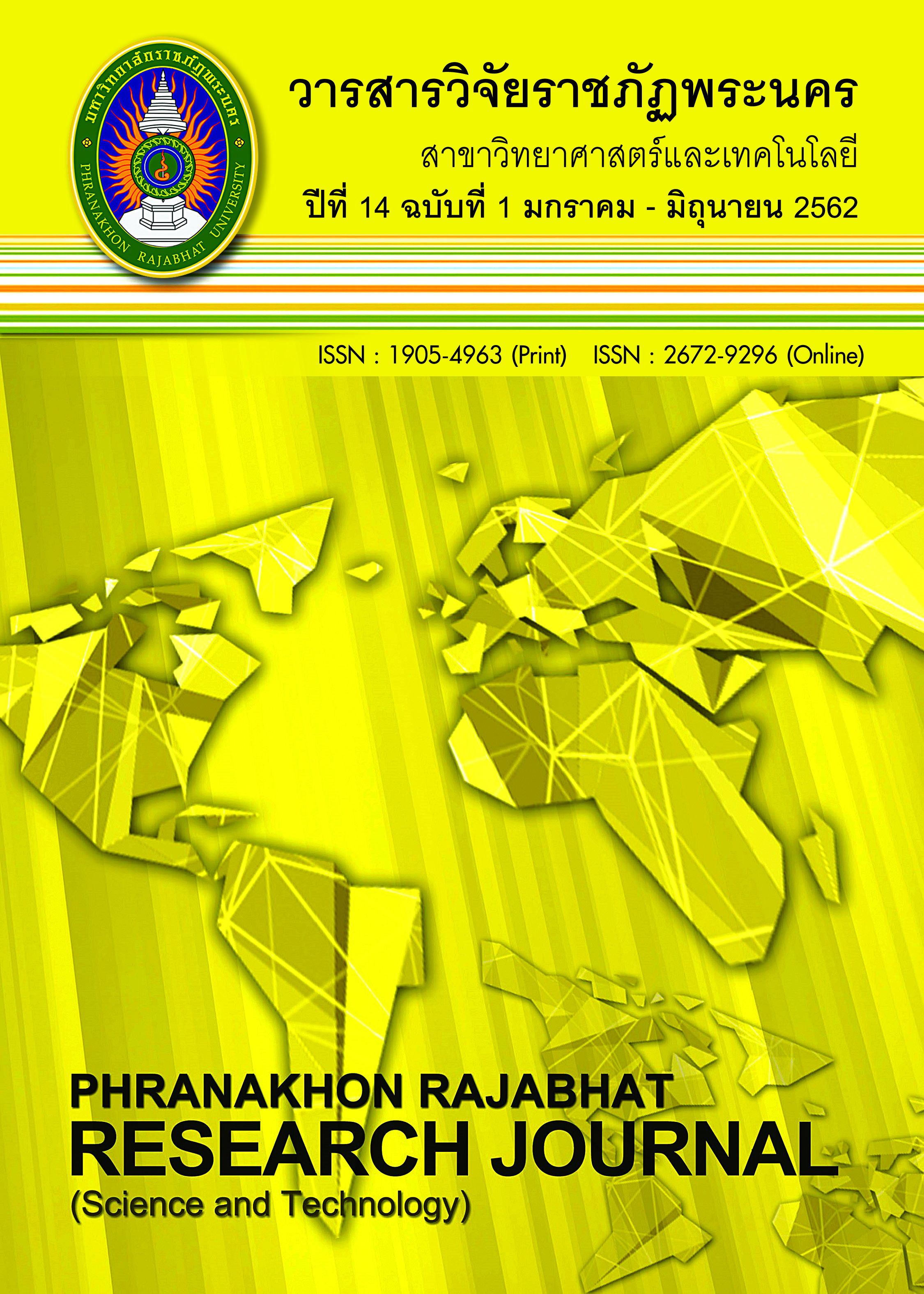ANTHOCYANIN CONTENT, ANTIBACTERIAL ACTIVITY AND ANTIOXIDANT CAPACITY OF PURPLE CORN COB EXTRACT VIA ULTRASONIC EXTRACTION
Keywords:
anthocyanin, purple waxy corn, extraction, antibacterial activityAbstract
This research work was a study of anthocyanin extraction from purple waxy corn cob using acetone acidified by hydrochloric acid as an extracting solvent accompany with ultrasonic technique. The work was emphasized on the amount of anthocyanin extract and the evaluation of their antimicrobial activity and antioxidant capacity. The extract was analyzed by UV-VIS spectroscopy for its total anthocyanin content. The results showed that the total anthocyanins content was 7,869.26 μg CGE/g DW. The antibacterial activity test of the extract was performed and determined for their minimal inhibitory concentration (MIC) and minimal bactericidal concentration (MBC) in two species of bacteria namely Escherichia coli and Staphylococcus aureus. It was found that the MIC and MBC values of Escherichia coli were similar and they were equal to 25 mg/mL. Whereas the MIC value of 50 mg/mL and the MBC value greater than 200 mg/mL were found for Staphylococcus aureus. The antioxidant capacity of anthocyanin extract was tested with two methods namely DPPH assay and FRAP assay. It was revealed that anthocyanin extract exhibited antioxidant characteristic in both tests. Result from DPPH assay showed that antioxidant activity of anthocyanin extract was 1.5 and 4 times higher than vitamin C and vitamin E, respectively.
References
Brand-Williams, W., Cuvelier, M. & Berset, C. (1995). Use of Free Radical Method to Evaluate Antioxidant Activity. LWT-Food Science and Technology. 28(1), 25-30.
Butkhup, L. (2013). Comparative Study of Flavonoid Contents and Antioxidant Property of Different Mulberry Fruits. Bangkok: The Thailand Research Fund. (in Thai)
Department of Science Service. (2010). Anthocyanin. Bangkok: Ministry of Science and Technology. (in Thai)
Giusti, M.M. & Wrolstad, R.E. (2001). Characterization and Measurement of Anthocyanins by UV-Visible Spectroscopy. In Current Protocols in Food Analytical Chemistry (pp. F1.2.1-F1.2.13). New York: John Wiley & Sons Inc.
Hafidh, S., Breznenová, K. & Honys, D. (2012). De Novo Post-Pollen Mitosis II Tobacco Pollen Tube Transcriptome. Plant Signaling & Behavior. 7(8), 918-921.
Hagiwara, A., Miyashita, K., Nakanishi, T., Sano, M., Tamano, S., Kadota, T. & Shirai, T. (2001). Pronounced Inhibition by a Natural Anthocyanin, Purple Corn Color, of 2-Amino-1-Methyl-6-Phenylimidazo [4,5-b] Pyridine (PhIP)-
Associated Colorectal Carcinogenesis in Male F344 Rats Pretreated with 1,2-Dimethylhydrazine. Cancer Letters. 171(1), 17-25.
Harakotr, B., Suriharn, B., Tangwongchai, R. & Lertrat, K. (2014). Effects of Harvesting Times and Cooking Methods on Anthocyanin Content and Antioxidant Activity in Purple Waxy Corn Hybrids. Khon Kaen Agriculture journal. 42(3), 337-346. (in Thai)
Jing, P. (2006). Purple Corn Anthocyanins: Chemical Structure, Chemoprotective Activity and Structure/Function Relationships. Doctoral Dissertation, The Ohio State University, USA.
Khampas, S. (2014). Effects of Locations on Phenolic Anthocyanin, Carotenoid Contents and Antioxidant Capacity in Vegetable Corn. Master of Science Thesis in Agronomy, Graduate School, Khon Kaen University. (in Thai)
Li, J., Walker, C.E. & Faubion, J.M. (2011). Acidulant and Oven Type Affect Total Anthocyanin Content of Blue Corn Cookies. Journal of the Science of Food and Agriculture. 91(1), 38-43.
Muangrat, R., Suwan, S. & Suthakit, P. (2015). Effect of Various Conditions in Ultrasonic Extraction on Total Anthocyanin Content of Purple Waxy Corn. Journal of Science and Technology. 23(5), 783-796. (in Thai)
Rath, D., George, J., Mukherjee, A., Naskar, S.K. & Mohandas, C. (2016). Antibacterial Activity of Leaf and Tuber Extract of Orange, Purple Flesh Antioxidants Rich Sweet Potato (lpomoea batatas (L.)). Merit Research Journal of Agricultural Science and Soil Sciences. 4(4), 67-71.
Somted, P., Peeraphunth, S., Amnueysit, K. & Amnueysit, P. (2015). Antibacterial Activity of Purple Rice Extracts on Growth Inhibition of Human Pathogenic Bacteria. In Proceedings of 53rd Kasetsart University Annual Conference: Plants, Animals, Veterinary Medicine, Fisheries, Agricultural Extension and Home Economics (PP. 574-581). Bangkok: The Thailand Research Fund. (in Thai)
Soria, A.C. & Villamiel, M. (2010). Effect of Ultrasound on the Technological Properties and Bioactivity of Food: A Review. Trends in Food Science & Technology. 2(17), 323-331.
Srithong, P., Kajsongkram, T., Bangchonglikitkul, C. & Boonsupthip, W. (2014). Effects of Solvent Type and Solid to Solvent Ratio on Antioxidant Compounds Extraction from Purple Corn (Zea mays L.) Seed and cob. In Proceedings of
52nd Kasetsart University Annual Conference: Agro-Industry (PP. 138-145). Bangkok: The Thailand Research Fund. (in Thai)
Tao, Y., Wu, D., Zhang, Q.A. & Sun, D.W. (2014). Ultrasound-assisted Extraction of Phenolics from Wine Lees: Modeling Optimization and Stability of Extracts during Storage. Ultrasonics Sonochemistry. 21(2), 706-715.
Yang, Z. & Zhai, W. (2010). Identification and Antioxidant Activity of Anthocyanins Extracted from the Seed and Cob of Purple Corn (Zea mays L.). Innovative Food Science & Emerging Technologies. 11(1), 169-176.
Downloads
Published
Issue
Section
License
โปรดกรอกเอกสารและลงนาม "หนังสือรับรองให้ตีพิมพ์บทความในวารสารวิจัยมหาวิทยาลัยราชภัฏพระนคร สาขาวิทยาศาสตร์และเทคโนโลยี" ก่อนการตีพิมพ์




